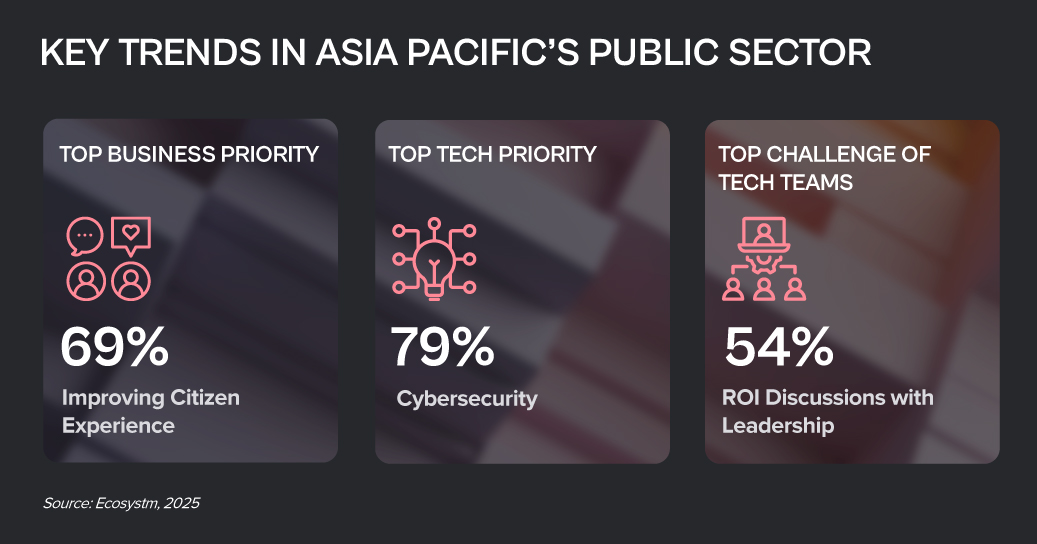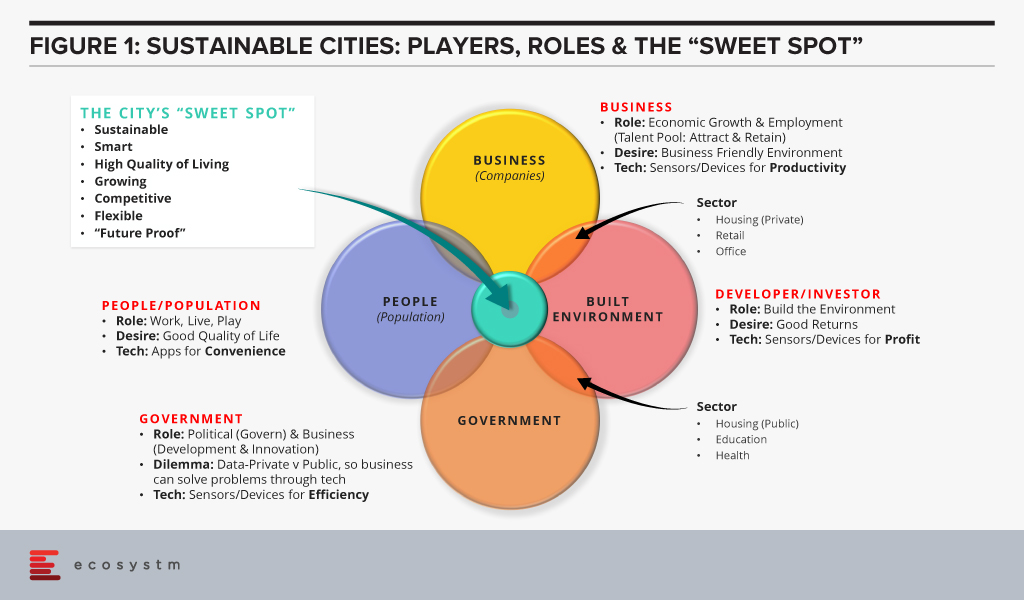As rapid technological change, rising citizen expectations, and growing demands for efficiency and transparency converge, the public sector stands at a pivotal crossroads. Profound, system-wide transformation is no longer a future ambition – it is an urgent imperative. From streamlining services and optimising resources to strengthening engagement and building more resilient infrastructure, the challenges and opportunities facing governments are immense.
Now is the time to reimagine how innovation, technology, and a citizen-first mindset can come together to reshape the very fabric of the public sector.

Click here to download “Future Forward: Reimagining the Public Sector” as a PDF.
Smarter City Management with Digital Twin
GovTech Singapore faced challenges in managing data from smart infrastructure as part of its Smart Nation initiative. They needed a more efficient way to visualise and analyse data from sources like smart lamp posts to improve urban management and resource optimisation.
GovTech implemented a digital twin solution that integrates real-time data from environmental sensors and traffic cameras into a dynamic 3D visualisation platform, enhanced by AI-driven analytics for predictive maintenance and resource allocation.
This solution provided valuable operational insights, reduced maintenance costs, and improved responsiveness to urban challenges. It boosted scalability and performance, optimising city planning and advancing the Smart Nation initiative towards more sustainable and efficient urban development.
Digital Leap for Accessible Governance
Scattered across the Indian Ocean, the Maldives faced a major challenge: delivering government services to citizens spread over 1,000 islands without forcing them to travel. The Ministry of Environment, Climate Change and Technology aimed to build a digital economy that could bring essential services directly to every island, while cutting costs and supporting sustainability goals.
The Ministry unified government agencies on a single, secure digital platform, enabling cloud-based collaboration, virtual meetings, and streamlined access to services.
Now, 20,000 public servants collaborate online, reducing travel, paper use, and operational costs. Government services have become faster and more accessible, solar energy projects are managed more efficiently, and citizens can access services – from banking to legal hearings – without leaving their islands. With digitalisation now embedded, the Maldives is laying the groundwork for AI-driven innovation and further advances in sustainable governance.
Enhancing Urban Resilience
With rising flood risks and extreme weather, Melbourne Water needed a faster, smarter way to maintain its 4,000 stormwater grates. Manual inspections were slow, costly, and couldn’t keep up with intensifying storms. Crews struggled to inspect grates across 14,000 sq km, often arriving too late or checking clear grates. Frequent site visits drove up costs, safety risks, and stretched resources, while the city needed to scale inspections without overburdening crews.
Melbourne Water implemented a cloud-based image recognition system with real-time cameras, using AI to detect blockages and trigger work orders only when needed.
The system is expanding beyond trial sites to cover critical points in the drainage network, with early results showing tens of thousands in annual savings and further efficiency gains. By freeing up crews and reducing manual work, Melbourne Water is better prepared to manage flood risks and support the city’s sustainable growth.
Making the Cloud Shift to Address Bottlenecks
The Philippine national police force overhauled its outdated licensing system, where applicants endured weeks-long waits, repeated office visits, and costly delays. Staff were bogged down by manual checks, while on-prem systems struggled with capacity limits, poor scalability, and frequent outages.
By shifting to a cloud-native platform, processing times dropped from four weeks to 24 hours – a 96% improvement.
The system now handles 5x more applications daily, scaling automatically with demand. Secure cloud storage replaced legacy systems, freeing IT teams to focus on citizen services. A nationwide content network and built-in security keep access fast, reliable, and protected. The force is unifying IT on one cloud platform and rolling out disaster recovery to boost resilience and future-proof operations.
Streamlining Employee Services
The New Zealand Parliamentary Service needed a more efficient way to manage employee services. Previously reliant on 11 separate email inboxes and a third-party IT service desk, the system was slow, disjointed, and cumbersome. Onboarding and offboarding were a particularly time-sensitive challenge, often causing delays and frustrations.
To streamline operations, the service transitioned to a unified platform, consolidating services into a single portal.
This move cut response times from weeks to just two days and simplified access to essential services, improving employee satisfaction and operational efficiency. With real-time performance tracking and AI-driven case management, the Parliamentary Service is now equipped to scale and optimise service delivery as it continues its digital transformation.
Enhancing Weather Prediction
The Japan Meteorological Agency (JMA) faces the challenge of enhancing weather predictions, particularly for typhoons and torrential rains, as climate change increases their frequency and intensity.
JMA upgraded its supercomputing infrastructure to boost memory bandwidth and computational power, enabling higher-resolution forecasts and more accurate predictions for linear precipitation zones.
The result: JMA has improved the resolution of its local weather models, extending the forecast time for local predictions from 10 to 18 hours. The new system has also increased prediction accuracy for linear precipitation zones, raising the probability of forecasting these events 15 hours in advance from 33% to higher levels. Additionally, the new infrastructure has reduced the number of nodes needed for some weather prediction models by up to 80%, optimising computational resources for other forecasting needs.

Today nearly 56% of the global population lives in an urban environment. The city has finally become the dominant place to live. Given the changing environment and increasing technology, the city has begun to dramatically change in the past 5-10 years. And it will continue to evolve and change at an increasingly faster pace.
As technology has developed and influenced the city, the term “Smart City” has become prevalent. Technology is an important attribute of a city’s evolution. However, it is just one of the attributes. A more encompassing and enduring term could be a “Sustainable City”. The definition of a Sustainable City that I subscribe to is:
“A vibrant community which can adapt and grow over the years, due to changing demographics and economic conditions. It is based upon multiple attributes.”
This definition begins to describe the holistic and long-term issues associated with the complexities of an urban environment. A Sustainable City has a goal of being an enduring and competitive place to work, live, learn, and play. It requires many aspects. Some of these are:
- Purpose. Entertain, eat, work, live, learn
- Activities. Walk, bike, play, work, learn, etc.
- Scale. Human scale not mega blocks
- Natural Environment. Location, terrain, water, etc.
- Environmental Implications. Resource usage, output disposal, environmental footprint, etc.
- Dynamic. Changing through the day/week as needed (festival, farmer’s markets, sporting event)
- Transportation. Walk, bike, mass transit – beyond cars
- Connectivity. Smart & effective infrastructure (utility & transportation coordination, etc.)
- Built Environment. Smart & efficiently operated buildings, spaces, etc.
A city is also a three-dimensional physical puzzle. It is composed of multiple layers: Subterranean level (utilities, transportation, walkways, retail); Ground level (streets, walkways, public spaces, open areas, building entrances); Concourse (walkways, retail, elevated rail, etc.); and Air Space (skyscrapers, bridges). This three-dimensional layout adds a level of complexity.
Key Stakeholders in a Sustainable City
Another important layer to consider consists of the four main players that need to work together:
- People (employees, students, families, tourists)
- Businesses (large, small/medium, start-ups, etc.)
- Built Environment (developers, real estate investors, consultants, designers, engineers, etc.)
- Government (local and regional)
For a city to be enduring and sustainable, the four main players need to work in a concerted effort. They need to discuss, advise, decide and provide for an environment which can change or be modified based upon a particular city’s needs. No one player truly has the ability to control how the city develops over time. Instead all of them work together along with the marketplace and land economics to determine the success of a city in the long run. Idea generation can come from any of these players and is tested in the marketplace. Figure 1 shows the interactions between these four key stakeholders. When all the groups work together, they are able to attain that “Sweet Spot” which enables a location to have the characteristics of a sustainable Global City. In the most simplistic terms, the Sweet Spot for a Sustainable City is the on-going quality of life that the city provides to its occupants.

The Dynamic Nature of a Sustainable City
Some believe that once a city or regional masterplan has been developed and approved the only thing left is to implement and enjoy. As a city and its inhabitants are dynamic, a longer-term sustainable view might be that the completion of the environment is just a starting point. The cases in point are the great global cities whose origins have started many generations ago, such as London, New York, Berlin, Tokyo, and so on This means that through use, the environment and space will constantly be assessed to evaluate if they are meeting the changing needs of the city or location. The appropriate adjustments or modifications are required over time. This is what has been done over the past centuries for many global cities. The difference between then and now is that with technology permeating everywhere, the ability to assess and adjust the environment will now be done at a much faster rate.
As builders and/or occupants of the environment we are just the current Stewards of the urban environment. Stewardship is a delicate balance between Return on Investment and Return to Society. The city is a dynamic environment which will continue to evolve over time based upon its changing needs. We have to determine whether we are going to change and improve the environment or just “pluck the fruits” from the existing assets. We should make sure that when we design and develop the urban environments it is with long-term sustainability in mind.















